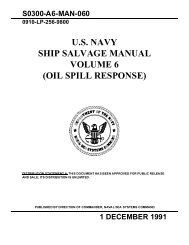June 2011 - Supervisor of Salvage and Diving
June 2011 - Supervisor of Salvage and Diving
June 2011 - Supervisor of Salvage and Diving
You also want an ePaper? Increase the reach of your titles
YUMPU automatically turns print PDFs into web optimized ePapers that Google loves.
Liberia:<br />
Rebuilding a Nation From the Seafloor Up<br />
By: IT3 Orin Shulte <strong>and</strong> CM2 Tory Madsen (SCW/DV)<br />
W<br />
“ e have been asked by our task<br />
force to deploy to the West<br />
Coast <strong>of</strong> Africa <strong>and</strong> construct a boat<br />
ramp <strong>and</strong> floating pier for the Liberian<br />
Coast Guard, developing overall international<br />
relationships between the Liberian<br />
government <strong>and</strong> the United States.<br />
We have a lot <strong>of</strong> hard, technical work<br />
ahead <strong>of</strong> us. Much <strong>of</strong> your time <strong>and</strong> effort<br />
has gone into getting us this far. This<br />
will be the crown jewel <strong>of</strong> our deployment<br />
so let’s finish strong.” As the words<br />
<strong>of</strong> SWC Daniel Lowry (SCW/DV) resonated<br />
through the warehouse on Camp<br />
Mitchell, Underwater Construction Team<br />
(UCT) Construction Dive Detachment<br />
(CDD) CHARLIE prepared to embark<br />
on their final construction job for their<br />
deployment cycle. They had already had<br />
a successful deployment completing international<br />
Divers training in Odessa,<br />
Ukraine, constructing a floating pier for<br />
the Cameroon Rapid Intervention Battalion,<br />
<strong>and</strong> restoring port security barrier<br />
sections for the Royal Spanish Navy<br />
in Rota, Spain. Constructing the boat<br />
ramp <strong>and</strong> floating pier for the developing<br />
Liberian Coast Guard would be the<br />
culmination <strong>of</strong> the Seabee Divers’ sixmonth<br />
deployment. With pinpoint focus<br />
<strong>and</strong> unwavering determination, the<br />
first chalk <strong>of</strong> Seabee Divers made the<br />
transit to the air terminal, loaded their<br />
gear, <strong>and</strong> set <strong>of</strong>f for Monrovia, Liberia.<br />
For the developing Liberian government,<br />
the construction <strong>of</strong> a floating pier<br />
<strong>and</strong> small watercraft boat ramp would<br />
play a critical role in combating narcotics<br />
trafficking <strong>and</strong> terrorism. Liberia’s burgeoning<br />
Coast Guard has no current operational<br />
port to conduct training or real<br />
world missions to contest these threats.<br />
With the installation <strong>of</strong> the pier <strong>and</strong> boat<br />
ramp the Liberian Coast Guard will be<br />
able to provide the security <strong>and</strong> safety<br />
that the country has been working toward<br />
since 2003.<br />
Completing the mission in Liberia<br />
would be a huge undertaking. Dive<br />
Det CHARLIE would be totally selfsufficient,<br />
having the majority <strong>of</strong> materials<br />
<strong>and</strong> gear flown in on three C-130<br />
chalks from Rota, Spain. The pier materials<br />
would be making the voyage via<br />
ship across the Atlantic from UCT ONE<br />
headquarters based in Joint Expeditionary<br />
Base - Little Creek. The pier materials<br />
were scheduled to arrive a week <strong>and</strong><br />
a half after the project started. Having no<br />
support from any adjacent units operating<br />
in country, all the construction, diving,<br />
mechanical operations <strong>and</strong> maintenance,<br />
excavating, <strong>and</strong> surveying would<br />
rest solely on CDD/CHARLIE.<br />
Touching down at the air terminal,<br />
work began immediately. Gear was unloaded<br />
<strong>and</strong> then transported to the Liberian<br />
Coast Guard Freeport Station where<br />
Dive Det CHARLIE began the initial<br />
preparations for project material storage.<br />
Several CONEX boxes had to be moved<br />
to support UCT ONE’s future diving operations<br />
near the water. The recompression<br />
chamber was assembled in one <strong>of</strong><br />
the CONEX boxes <strong>and</strong> the MK-3 surface<br />
supplied diving system was placed directly<br />
in front <strong>of</strong> the chamber. The setup<br />
gave the Seabee Divers an optimum<br />
work environment. Seabee Divers would<br />
be suited up <strong>and</strong> hatted right on the beach<br />
where they would walk directly to the<br />
pier project site to complete their underwater<br />
cutting <strong>and</strong> welding objectives.<br />
Sitting on dive station, staring at the<br />
murky waters <strong>of</strong> the African Atlantic,<br />
Seabee Divers submerged themselves<br />
beneath the sea <strong>and</strong> began the initial execution<br />
<strong>of</strong> the pier project. They began jetting<br />
<strong>and</strong> scrubbing operations to prepare<br />
the piles for cutting. While the Seabee<br />
Divers worked relentlessly underneath<br />
the surface, members from CDD/CHAR-<br />
LIE tackled the prefabrication <strong>of</strong> the Geoweb®<br />
which would form the concrete<br />
boat ramp.<br />
Having already started on underwa-<br />
4<br />
<strong>June</strong> <strong>2011</strong>

















